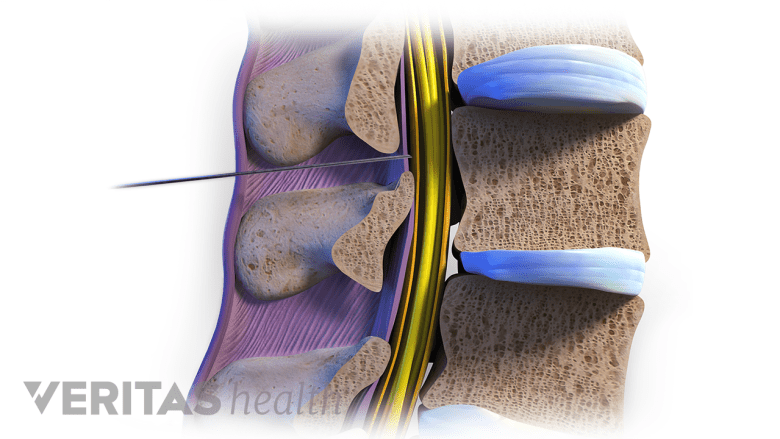When people think of surgical anesthesia, they typically think of general anesthesia. However, local anesthesia can block sensation to a smaller area for the purposes of surgery or other medical procedures. Both general and local anesthesia can be used for orthopedic surgeries and are described below.

Anesthesia may be administered via an injection in the epidural space of the spine.
People who smoke, abuse alcohol, or have other medical conditions are at a greater risk of complications regarding anesthesia. Patients concerned about their individual risks should talk to their doctor.
General Anesthesia
Typically, general anesthesia is administered through a needle in the vein of the patient’s arm. The patient is rendered unconscious—often referred to as being “put to sleep”—and does not feel pain. Patients under general anesthesia are closely monitored for changes in blood pressure, heart rate, and breathing.
See Types of Knee Surgery for Arthritis Treatment
Sometimes a patient can choose whether to have general or local anesthesia during surgery, but often the medical needs of their procedure dictate this choice.
Local (or Regional) Anesthesia
This type of anesthesia can be used instead of or in combination with general anesthesia. There are two types of regional anesthesia:
Spinal and epidural anesthesia techniques anesthetize the entire lower half of the body. The anesthesia is administered between vertebrae and affects the spinal cord. Spinal anesthesia is administered with a needle and goes into the fluid that surrounds the spinal cord. Epidural anesthesia is administered continuously through a catheter into the outermost area of the spinal canal, known as the epidural space. People are most familiar with the epidural technique because of its frequent use in childbirth.
Peripheral nerve blocks target the specific limb on which the surgeon is operating. This approach can stop sensation at the nerve roots, where nerves branch off from the spinal cord. For example, a nerve block may be administered to the lumbar plexus—a group of nerves that emerge through the lumbar spine and provide sensation to a leg—for a hip replacement.
Peripheral nerve blocks have become more common in recent years as medical technology has made them more precise and reliable.
A peripheral nerve block can be administered before surgery and used in combination with general anesthesia. Local anesthesia may be used for a brief time following surgery. This allows a patient to emerge from general anesthesia and regain consciousness without pain.
Patient-controlled Intravenous Analgesia
Pain must be controlled following surgery. Post-surgical pain differs from patient to patient. To account for these pain variations, hospital patients are sometimes given control of their own pain medication. The patient presses a button on a patient-controlled analgesia (PCA) pump, which then administers analgesia through an IV. The pump is programmed to deliver doses specific to the patient, so there is no risk of overdose.



